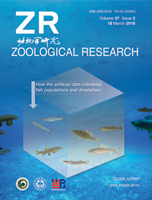
|
Zoological Research
Kunming Institute of Zoology, Chinese Academy of Sciences
ISSN: 2095-8137
Vol. 38, No. 3, 2017, pp. 146-154
|
 Bioline Code: zr17019
Bioline Code: zr17019
Full paper language: English
Document type: Research Article
Document available free of charge
|
|
|
Zoological Research, Vol. 38, No. 3, 2017, pp. 146-154
| zh |
H1N1流感病毒感染IL-1受体敲除小鼠诱发肺部免疫炎症失调与高死亡率
Guo, Lei; Wang, Yan-Cui; Mei, Jun-Jie; Ning, Ruo-Tong; Wang, Jing-Jing; Li, Jia-Qi; Wang, Xi; Zheng, Hui-Wen; Fan, Hai-Tao & Liu, Long-Ding
呼吸道病毒感染引发病毒性肺炎和急性肺损伤。IL-1细胞因子家族由促炎因子组成在体内免疫和炎症中发挥重要调控作用。已发现IL-1信号通过调节肺部抗病毒免疫炎症反应保护机体抵抗呼吸道流感病毒感染。本文通过呼吸道感染IL-1受体敲除小鼠(IL-1R1-/-)H1N1流感病毒,对感染后小鼠肺部免疫细胞浸润、细胞因子释放、肺损伤和存活率进行分析。实验结果发现,与野生型感染小鼠相比,IL-1R1-/-小鼠在感染早期天然免疫反应失调,表现为肺泡灌洗液中嗜中性粒细胞数量和细胞因子IL-6、TNF-α、G-CSF、KC、MIP-2的表达量显著升高。感染后期IL-1R1-/-小鼠肺部获得性免疫反应下调,肺灌洗液中Th1细胞反应、CD8阳性细胞比例和血清抗体水平均显著低于野生型小鼠。免疫反应受损同时造成IL-1R1-/-小鼠肺部病毒清除受到削弱和高死亡率。组织病理学分析揭示,感染初期IL-1R1-/-小鼠肺部炎症反应弱于野生型小鼠而感染后期出现严重肺部病理改变。此外,与野生型小鼠相比,IL-1R1-/-小鼠感染后骨髓嗜中性粒细胞生成与募集入肺显著减少。综合上述结果,IL-1信号在呼吸道流感病毒感染中具有调节肺部抗病毒免疫反应和炎症反应的保护性作用,缺失IL-1受体影响嗜中性粒细胞募集入感染肺部和肺部炎症因子的表达。
流感病毒; 肺炎; IL-1受体1; 中性粒细胞
|
| |
| en |
Pulmonary immune cells and inflammatory cytokine dysregulation are associated with mortality of IL-1R1-/- mice infected with influenza virus (H1N1)
Guo, Lei; Wang, Yan-Cui; Mei, Jun-Jie; Ning, Ruo-Tong; Wang, Jing-Jing; Li, Jia-Qi; Wang, Xi; Zheng, Hui-Wen; Fan, Hai-Tao & Liu, Long-Ding
Abstract
Respirovirus infection can cause viral pneumonia and acute lung injury (ALI). The interleukin-1 (IL-1) family consists of proinflammatory cytokines that play essential roles in regulating immune and inflammatory responses in vivo. IL-1 signaling is associated with protection against respiratory influenza virus infection by mediation of the pulmonary anti-viral immune response and inflammation. We analyzed the infiltration lung immune leukocytes and cytokines that contribute to inflammatory lung pathology and mortality of fatal H1N1 virus-infected IL-1 receptor 1 (IL-1R1) deficient mice. Results showed that early innate immune cells and cytokine/chemokine dysregulation were observed with significantly decreased neutrophil infiltration and IL-6, TNF-α, G-CSF, KC, and MIP-2 cytokine levels in the bronchoalveolar lavage fluid of infected IL-1R1-/- mice in comparison with that of wild type infected mice. The adaptive immune response against the H1N1 virus in IL-1R1-/- mice was impaired with downregulated anti-viral Th1 cell, CD8+ cell, and antibody functions, which contributes to attenuated viral clearance. Histological analysis revealed reduced lung inflammation during early infection but severe lung pathology in late infection in IL-1R1-/- mice compared with that in WT infected mice. Moreover, the infected IL-1R1-/- mice showed markedly reduced neutrophil generation in bone marrow and neutrophil recruitment to the inflamed lung. Together, these results suggest that IL-1 signaling is associated with pulmonary anti-influenza immune response and inflammatory lung injury, particularly via the influence on neutrophil mobilization and inflammatory cytokine/chemokine production.
Keywords
Influenza; Lung inflammation; IL-1 receptor 1; Neutrophil
|
| |
© Copyright 2017 - Editorial Office of ZOOLOGICAL RESEARCH
Alternative site location: http://www.zoores.ac.cn/
|
|
